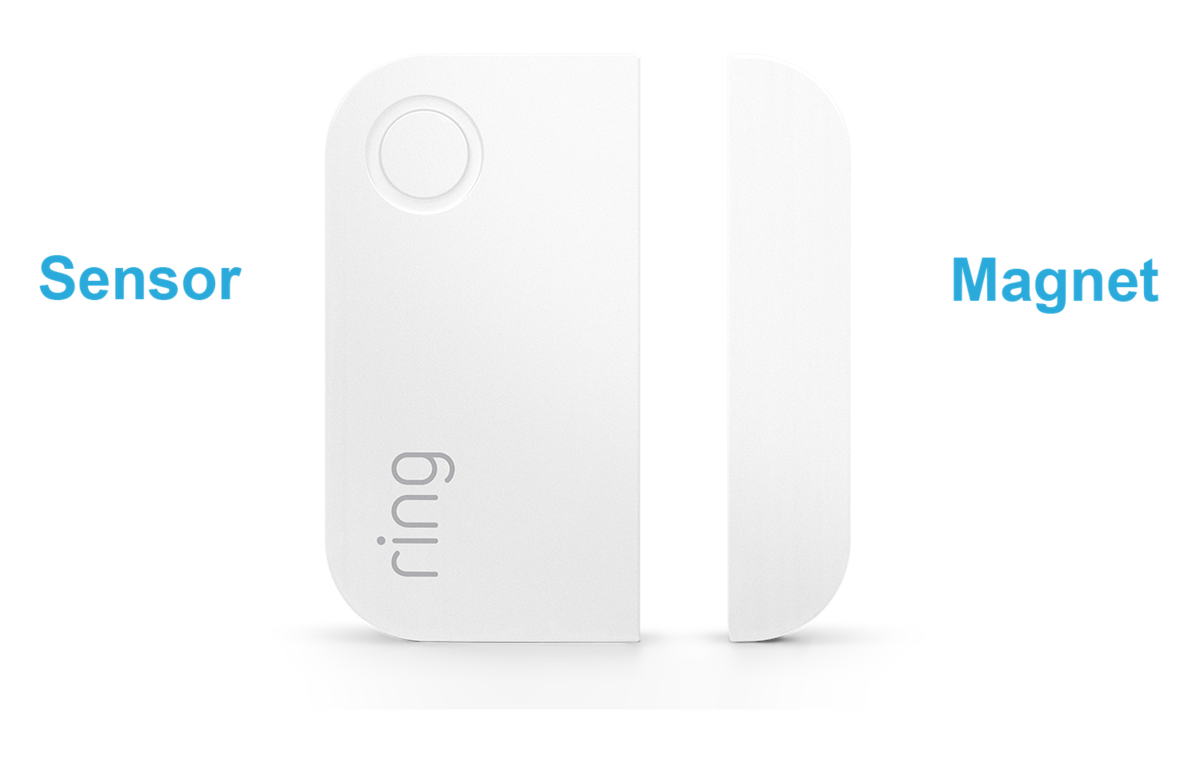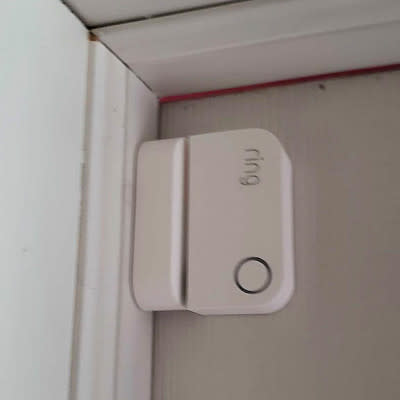Installing your Contact Sensor (2nd Generation)
If your door or window has a unique frame, size structure or moulding, you may want to take a creative approach to mounting the Ring Alarm Contact Sensor (2nd Generation).
Note: Before you can begin mounting the Contact Sensor, you need to follow the steps in the app and add it to your Ring Alarm.
The Contact Sensor has two parts - the sensor and the magnet:

If you hold both parts of the Contact Sensor together and then pull them apart, you should see the LED ring flash green just once, and hear a small chirp tone from the Base Station. Chirp tones are enabled by default.
Your Contact Sensor installation will work as long as it meets these three criteria:
- The space between the Contact Sensor and the magnet is 2.5 cm or less.
- When you open the door or window, you see the LED flash green (and hear the chirp tone, if enabled).
- There needs to be 1.25 cm of space around the sensor so you can slide it open to replace the batteries.
You can mount either the Contact Sensor on the door/window and the magnet on the frame, or the other way around.
 |  |
Your Contact Sensor or magnet can be mounted at an angle if you have curved or decorative moulding.
 |  |
If your closed window or door doesn’t match up with the frame or moulding, you can offset mount the Contact Sensor and magnet. Just make sure that the two pieces are less than 2.5 cm apart, and you see the LED blink and hear the chime when you open the door or window.
 |  |
You can rotate the magnet or sensor for a more secure fit.
 |  |
You can also rotate the Contact Sensor or the magnet so they meet at a right angle. In order to make these fit, your Contact Sensor may need to be mounted about 2 cm from the edge of the door or frame. These images illustrate how to get creative:
 |  |
 |  |
Casement windows create a special challenge. Installing the sensor on your window frame and the magnet on the window might work for you, as long as there's enough room for you to slide off the sensor to change the batteries.
French doors can be easily secured by placing the Contact Sensor on one door, and the magnet on the other.
 |  |
Removing the slim magnet from your Contact Sensor
If you are installing your Contact Sensor on a window or door with a narrow frame, you can remove the slim magnet from inside the magnet so that it fits into the available space.
To remove and install the slim magnet:
- Take the magnet component of your Contact Sensor.
- Lever the back off the magnet component with a small flat head screwdriver.
- Remove the slim magnet.
- Install the slim magnet next to the sensor, using the adhesive pad.

Using a Ring Alarm Contact Sensor Riser
If you are still having a problem getting your Contact Sensor positioned correctly, a Ring Alarm Contact Sensor Riser (sold separately) could be the solution. Window and door finishes are sometimes uneven and prevent the sensor and magnet from being within the required 2.5 cm maximum detection gap.



The Contact Sensor Riser adds 1 cm in height to the Contact Sensor. It also comes with an additional magnet that is 1 cm taller than your original one. Use these accessories as needed to improve the positioning and function of your Contact Sensor.
Here is an example of a Contact Sensor installed with the taller magnet that comes with the Contact Sensor Riser:

* The Contact Sensor Riser only works with the Ring Alarm Contact Sensor (2nd Generation).
* For indoor use only.
How to install the Contact Sensor Riser
To install the Contact Sensor Riser, follow these steps:
 | 1. Disarm your Ring Alarm system using the Ring app or Keypad. 2. Slide the Contact Sensor off of its mounting bracket. 3. Attach the mounting bracket to the Riser. Make sure it snaps in securely. 4. Slide the Riser onto the sensor. Make sure it slides in completely. 5. Install the sensor and magnet and make sure that they are within the required 2.5 cm maximum detection gap. 6. Open your door or window to confirm that the Contact Sensor detects when the door or window is opened and closed. |
A few more tips for mounting your Contact Sensor:
- You can mount your Contact Sensor around almost any part of your door or window.
- If you have a Casement Window, be careful not to leave the window open during rain or snow. Water can damage the Contact Sensor.
- Avoid the side of the door with the hinges.
- Skip areas close to a mail slot to prevent someone from reaching in and tampering with the Sensor.
- Avoid mounting on clear glass windows to prevent intruders from identifying your security measures.
- Steel doors and aluminium door frames may occasionally cause interference for the Contact Sensor. Test the Sensor on your door or window to determine if there are any issues.
Still need more help? Check out this video.
